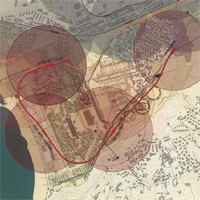Technical Consensus and Integration between Transport and Territory: the Bagnoli Project
Abstract
The paper wants to analyze a highly operative aspect of the interventions related to the Bagnoli Project and the extension of the subway line nr. 6 to Bagnoli. The two projects strictly integrate the urban transformation projects in the implementation of the mobility system. The two societies that realize the project are Bagnolifutura SpA Urban Transformation Society, and Ansaldo STS SpA. The first has the task to act the executive urban plan of Bagnoli-Coroglio; the latter is one of the main company in the global railway & mass transit transportation systems and it is licenseed for design and construction of the line nr 6. The paper, in the whole complex process, wants to analyze particularly the long coordination process among the subjects responsible for the various design and construction phases and the equally hard work necessary for the granting of approvals. In other words, the paper wants to show that the expected and/or obtained results in terms of land-transport integration come not only from a rigorous design process, but mainly from a structured, long and often difficult activity of technical consensus building. For this result many meetings are necessary , field tests, surveys, expert analysis, but also the definite time for closing the significant phases of the procedure, avoiding the risk of indefinite times for discussion, never compatible with the timing of the funding. The definition of the trackwork, for example, is a synthesis moment of many requirements that must be met; their acceptance is never immediate, but it is verified only after a recursive process that assembles one after the other the pieces of a mosaic. It is a team effort involving multiple disciplines and a large number of professionals; they must work in close contact, making sure that the information’s flow in the right way, that the taken decisions are transparent, clear, and that are known to all; everyone must have the availability to revise some of the own work or, in extreme cases, to restart the process. A necessary first step of comparison has involved the layout of the railway line and the level of the track. During several meetings, audits, and technical evaluation stages, a series of design alternatives are studied, and are discarded all the hypotheses of trenches or close to the ground parts. The only possible choice was the creation of a tunnel starting from Campegna, that continues along the Sport Park, reaches Steel Mill, Science City and the Park Gate, serving the nodal points in the area. Among others, two engineering aspects are faced in the project’s development: the provision of electricity and water for the metro line, and the interference of the line with a large sewer pipe in the area. Another aspect is the integration between the architecture and the landscape as regards the stations and the gateways, with particular attention to the industrial archeology buildings.
Downloads

Copyright (c) 2014 Tema. Journal of Land Use, Mobility and Environment

This work is licensed under a Creative Commons Attribution 4.0 International License.
Authors who publish in this journal agree to the following:
1. Authors retain the rights to their work and give in to the journal the right of first publication of the work simultaneously licensed under a Creative Commons License - Attribution that allows others to share the work indicating the authorship and the initial publication in this journal.
2. Authors can adhere to other agreements of non-exclusive license for the distribution of the published version of the work (ex. To deposit it in an institutional repository or to publish it in a monography), provided to indicate that the document was first published in this journal.
3. Authors can distribute their work online (ex. In institutional repositories or in their website) prior to and during the submission process, as it can lead to productive exchanges and it can increase the quotations of the published work (See The Effect of Open Access)
